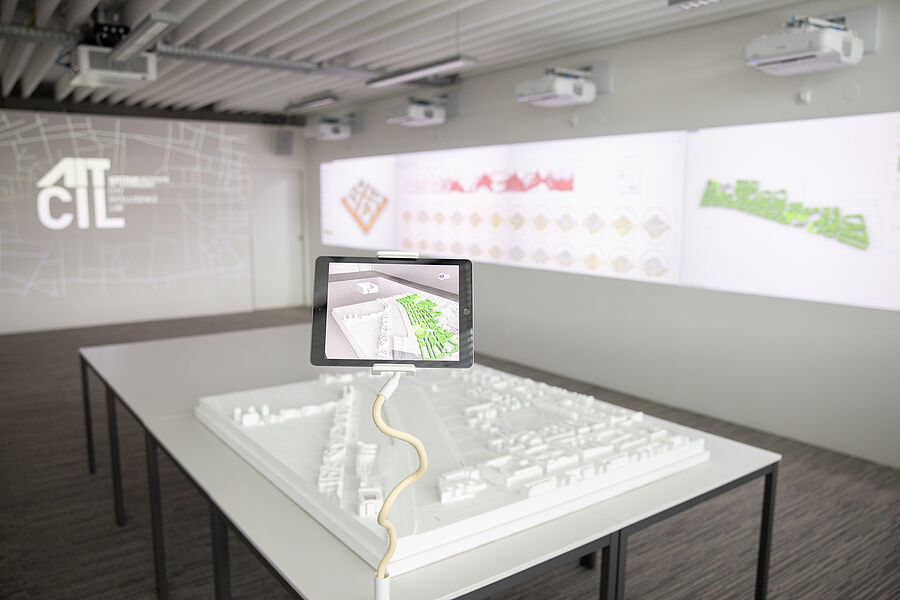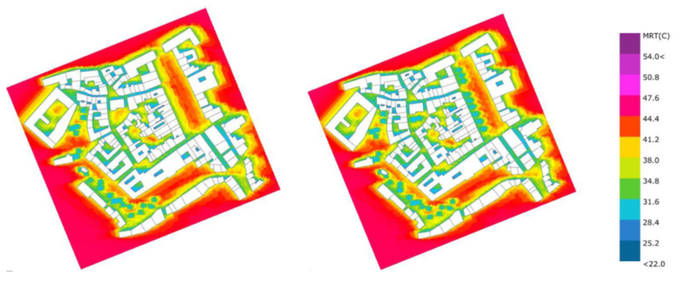Climate Change & Climate Resilience – Challenges and Solutions for Sustainable Quality of Life
Climate change is an increasing challenge, especially for cities and regions that are facing new demands on their infrastructure and planning. They are tasked with becoming climate-resilient in order to maintain a high quality of life for their residents. This requires measures aimed at enhancing the resilience of urban infrastructure – for example, against extreme weather events such as heatwaves, heavy rainfall, and droughts. Climate resilience refers to a system’s ability to adapt to climate change, manage its impacts, and recover from extreme events. It is about how well a community, ecosystem, or infrastructure can minimize negative effects and reduce potential risks by proactively creating structures that remain functional and attractive, even under changing climatic conditions.
Climate resilience: developing strategies and measures
Transformation paths and insights in climate impact research
Adapting to climate change through climate resilience requires a wide range of strategies and measures that must be implemented at both the local and regional levels. Our research approach to developing climate-resilient strategies and measures includes the following key areas:
- Cross-scale simulation models play a crucial role in understanding the impacts of current and future climate changes at regional, urban, and local levels, and in developing consistent measures across these scales.
- Climate-resilient planning consultancy at local and regional levels is essential to help cities and municipalities adapt to changing climatic conditions. We pursue a holistic approach that integrates the built environment, energy, and mobility.
- Climate risk and vulnerability analysis is vital for identifying weak points and prioritizing appropriate adaptation measures.
- Identifying effective measures to improve thermal comfort and quality of life in cities is also important to ensure the well-being of the population.
- Exploring nature-based solutions, including their design, evaluation, and the development of roadmaps, offers a sustainable way to strengthen the resilience of cities to climate change.
Ultimately, adapting to climate change requires a comprehensive and coordinated approach at different levels to strengthen the resilience of communities and cities.
AIT solutions for climate resilience in cities and regions
- Microclimate simulations for urban strategies (Urban Climate Modelling)
- Urban climate analyses
- Vulnerability analyses for cities
- Analyses of climate risks within the framework of the CSRD/EU taxonomy
- Conzepts/strategies for increasing climate resilience (nature-based solutions)
- Tools for evaluating urban water management
- Mikroclimate simulations for open spaces and neighborhoods to support planning
Microclimate simulations for urban strategies (Urban Climate Modeling)
Urban climate modeling is an important approach for achieving various goals related to enhancing urban environmental comfort. This includes improving thermal comfort and wind comfort in outdoor spaces during both summer and winter months. By using climate models that allow for analysis of the current state as well as the development of scenarios and forecasts, it is possible to predict the potential impacts of urban planning decisions and climatic changes. Based on these analyses, impact assessments can be conducted and action plans developed, which may include strategies, guidelines, a toolbox, and concrete implementation projects. These integrated urban climate modeling approaches provide valuable tools for designing future-proof and climate-resilient cities.
Climate resilience and urban climate analyses
The development of a comprehensive urban climate analysis in accordance with VDI Guideline 3787 Part 1 is crucial for gaining an in-depth understanding of climatic conditions in urban areas. By utilizing climate analysis maps, including specific thematic maps such as “cold air flows,” urban climatic phenomena can be quantified and scientifically evaluated. This analysis enables the identification of urban climatological phenomena and their interactions with the surrounding environment—such as green infrastructure with high climate relevance, local heat islands, and cold air movements. The added value of such an analysis lies not only in providing an essential foundation for future land-use and urban development planning, but also in reducing thermal stress on the population under future climate conditions.
Vulnerability analysis for cities
Austria’s cities are increasingly confronted with the impacts of climate change, which threaten their built, blue (water), and green infrastructure systems, as well as the quality of life of their populations.
The VESPA Tool (Rapid Vulnerability Assessment for Practical Application in Cities) is a prototype for a quick vulnerability test that provides cities with an evidence-based foundation to assess risks and challenges. Using a web-based tool, cities can create and analyze individual vulnerability profiles, turning the assessment into an instrument for promoting sustainable and functional open space design in both urban and rural environments.
The indicators cover economic, social, and infrastructural conditions that determine a city's susceptibility to crises. This data-driven analysis is complemented by qualitative assessments from local stakeholders, providing a comprehensive picture of urban challenges.
Analysis of physical climate risks within the framework of the CSRD/EU taxonomy
The introduction of the EU Taxonomy Regulation 2020, which provides the fundamental definition for the ESRS, with the aim of promoting sustainable economic activities, has led to major changes in reporting. The EU Taxonomy was adopted to create a binding understanding of which economic activities are considered sustainable. Therefore, economic activities must now be reported not only in terms of their economic viability but also in terms of their impact on the six environmental objectives listed below. Since the six objectives (1. Climate change mitigation, 2. Climate change adaptation, 3. Sustainable use and protection of water and marine resources, 4. Transition to a circular economy, 5. Pollution prevention and control, 6. Protection and restoration of biodiversity and ecosystems) cover relevant areas for the preservation of habitats, a significant contribution must be demonstrated in at least one of them, and the other five must not be adversely affected. In addition, compliance with minimum social safeguards must be demonstrated. A minimum requirement across all environmental objectives is to conduct a robust climate risk and vulnerability analysis, which aims to identify potential (future) risks to economic activities.
The demand for a climate risk and vulnerability analysis poses many challenges for companies, as the definition and required data of the involved components (hazard, exposure, vulnerability) are complex. However, it also offers a valuable opportunity to engage deeply with future climatic conditions and to understand how these may (or will) affect economic activity. The knowledge gained from this engagement is of immense importance, as it provides companies with the chance to become aware early on of the risks they may face. In addition to identifying potential risks, adaptation measures must be defined. This allows for effective actions to be taken in a timely manner to adapt and to minimize or even prevent potential damage.
The climate risk and vulnerability analysis offers the opportunity to make economic activities more robust and resilient in the face of the challenges posed by a changing climate, because the basic rule is: The earlier suitable climate protection and adaption measures are implemented, the easier and more efficiently the transformation to resilient economic activity can take place, and the more manageable the associated costs will be.
Concepts/strategies for increasing climate resilience in cities and regions (nature-based solutions)
Nature-based solutions offer a wide range of opportunities to strengthen the resilience of cities to climate change. These solutions leverage the natural elements of the environment to enhance urban spaces while also providing ecological benefits. Buildings can be considered key areas for the implementation of nature-based solutions, such as green roofs and green façades, which not only enhance aesthetics but also promote biodiversity. Additionally, nature-based solutions can be applied in open spaces, including trees, green areas, depaving, and vertical gardens, to reduce ambient temperatures and improve air quality. An important component is the monitoring of temperature in outdoor areas, façades, and indoor spaces to assess the effectiveness of these measures and adjust them as needed. By integrating nature-based solutions, cities can become more resilient to climate change while simultaneously creating livable and sustainable environments for their residents.
Tools for evaluating urban water management
Integrated urban water management is an innovative approach to the comprehensive and sustainable management of water resources in urban areas. This approach aims to integrate various aspects of water management, including water supply, wastewater treatment, stormwater management, and water protection. By taking a holistic view of these elements, it becomes possible to address the challenges posed by rapidly growing urban populations and changing environmental conditions. Integrated urban water management enables the efficient use and stewardship of water resources, helps to minimize water scarcity and flood risks, and supports the development of more resilient and sustainable urban environments.
Planning-Accompanying Microclimate Simulations for Open Spaces and Neighborhoods
The Open Space Design Assessment is a tool for evaluating the performance of open space designs based on a variety of criteria. These include agent-based pedestrian simulation, which enables the analysis and optimization of pedestrian behavior in open spaces. Additional aspects taken into account are solar exposure, sunshine duration, and thermal comfort, assessed both on an annual basis and during reference days and heatwaves. Another key component is the assessment of the impact of planned open spaces on stormwater, including the estimation of the amount of water to be discharged based on annual precipitation per person and local design rainfall events. Through impact assessment and the development of corresponding planning guidelines, the Open Space Design Assessment supports more resilient and people-centered urban planning.








